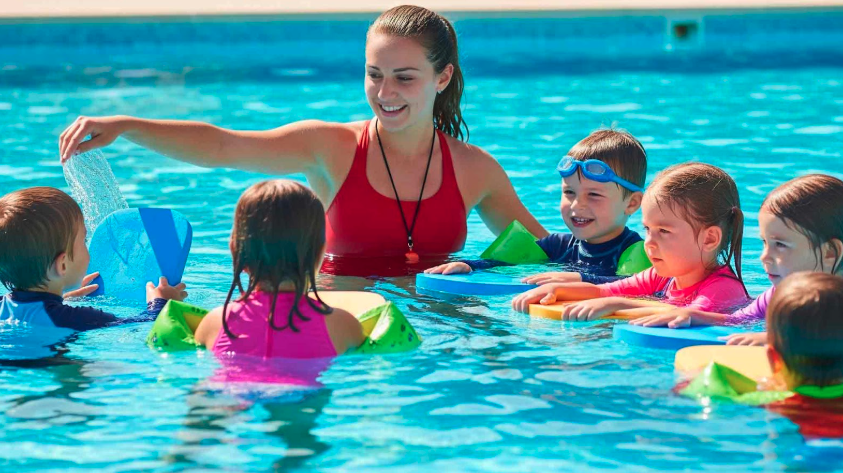Making Waves in Education: The Push for Water Safety in Public Schools

Every year in the United States, drowning claims the lives of approximately 4,000 people, an average of 11 deaths per day, and results in about 8,000 nonfatal incidents that often lead to long-term disabilities.
For children ages 5-14, drowning ranks as the second leading cause of unintentional injury death, and for those ages 1-4, it is the number one cause of death overall.
As schools seek to address the comprehensive well-being of their students in the aftermath of the COVID-19 pandemic, water safety education has emerged as a critical public health priority, creating both opportunities and responsibilities for K-12 educators.
Why Water Safety Is a Growing Priority in Schools
There are many reasons why water safety is becoming a priority in schools. Rising drowning rates, the lack of swimming skills, and stark racial disparities have made water safety a pressing concern for public schools seeking to protect every student.
Public Health Data
With over 4,500 drowning deaths annually in the U.S. between 2020 and 2022, an increase of roughly 500 deaths per year compared to 2019, experts warn that proven prevention strategies are more urgent than ever.
Socioeconomic Access Gaps
Nearly 40 million American adults lack basic swimming skills, and many children, especially those from low-income or underserved communities, never have the chance to learn in a formal setting. By incorporating water safety into public school curricula, districts can bridge this gap.
Post-COVID Catch-Up
The pandemic halted swim lessons and closed pools nationwide, exacerbating skill deficits and amplifying the need for in-school interventions.
Opportunity to Learn
Research from the USA Swimming Foundation highlights that black children are 5.5 times more likely to drown than white children. Native communities also face disproportionate drowning rates, calling for expanded relevant safety initiatives.
How States and Districts Are Implementing Water Safety Curriculum
Many states and districts are taking action to ensure students receive water safety curriculum early on.
- Florida: Early-grade students receive mandatory water safety lessons integrated into health and physical education (PE) standards, ensuring foundational knowledge before entering middle school.
- Texas: Collaborative initiatives with YMCAs and local aquatics centers provide both classroom instruction and in-pool practice, often at no cost to families.
- California: Title I schools in pilot regions have launched subsidized swim programs, combining bus transportation, swim gear distribution, and certified instructors to eliminate logistical barriers.
These are just a few examples. Other states are also taking steps. Missouri offers programs to provide free swim lessons at local swimming pools.
Types of Curriculum Models
Here are some examples of the different curriculum models schools and districts are implementing to educate students about water safety:
- Classroom-Based Lessons: Interactive modules cover topics like rip currents, buoyancy, and recognizing distress in others.
- In-Pool Instruction: Hands-on practice under certified lifeguards or PE teachers, reinforcing skills in a controlled environment.
- Standards Integration: Water safety competencies are integrated into existing physical education (PE) and health frameworks, with clear learning objectives and assessment rubrics.
The Role of Educators in Water Safety Instruction
If water safety education is to reach the level we want it to be, then teachers and school staff will play a crucial role in advancing this effort. From classroom teachers to school nurses, everyone can help out!
Classroom Teachers
Teachers can help by introducing core concepts, such as the “buddy system” and hazard recognition, and coordinate guest speakers or field trips to local pools.
P.E. Teachers
More specifically a Physical Education (PE) teacher can lead in-pool sessions or collaborate with community partners to deliver swim lessons, using differentiated instruction to meet students at their skill level.
School Counselors & Nurses
School counselors and nurses can help reinforce safety messaging through health fairs, newsletters, and one-on-one check-ins, linking water safety to broader wellness goals.
Certification Needs
As programs expand, schools increasingly require teachers to hold certifications in CPR, First Aid, and lifeguarding. Some districts are even funding Professional Learning Units (PLUs) or Continuing Education Units (CEUs) in aquatic instruction.
How Aspiring Teachers Can Prepare for Roles in This Space
For most educators, teaching water safety will be a new concept. To ensure they can provide students with accurate and helpful information, there are a few steps they can take to prepare.
Professional development for educators is ongoing, and knowledge of water safety is an integral part of that development.
Teachers can increase their knowledge of health and safety pedagogy, community partnership development, basic aquatic education, and water rescue principles.
These skills will provide a solid foundation for educating students on water safety.
Certification Pathways
Some states and districts may start to require certifications for water safety.
Educators can get a head start on this process by taking one of the following pathways to receive their official certification in water safety and instruction.
- State licensure with Health and PE endorsements
- American Red Cross or YMCA lifeguard training, CPR, and First Aid certifications
- Workshops in water rescue techniques and adaptive swim instruction
Pro Tip: Programs like 240 Certification offer aligned professional prep for teachers wanting to build credentials in health and safety education.
Looking Ahead: The Future of Water Safety in Schools
As the data continues to show a high number of drowning cases and the urgency of drowning prevention grows, we can expect to see an increasing number of schools taking steps to educate their students.
We have already started to see signs of changes coming.
- A growing number of state legislatures are already debating mandates for water safety education at specific grade levels, signaling long-term policy support.
- Nonprofits, aquatics centers, and health agencies are forging deeper alliances with school districts, offering grants, instructor training, and equipment donations.
- As school-based water safety champions, certified educators will not only teach skills but also advocate for sustainable funding and continuous program evaluation.
Conclusion
Water safety is no longer an optional extracurricular; it’s a life skill. By educating students about water safety, teachers can:
- Save lives
- Equip students with tools for lifelong safety.
Whether you’re an experienced educator or just starting your certification journey, there has never been a better time to make water safety a cornerstone of your teaching mission.
If you aspire to make a lasting impact, both in and out of the classroom, consider enhancing your credentials through targeted certification programs and join the wave of teachers transforming public schools into hubs of water safety excellence.
Boating
- Wyoming
- Wisconsin
- West Virginia
- Washington
- Virginia
- Vermont
- Utah
- Tennessee
- South Dakota
- South Carolina
- Rhode Island
- Pennsylvania
- Oregon
- Oklahoma
- North Dakota
- North Carolina
- New York
- New Mexico
- New Jersey
- New Hampshire
- Nevada
- Nebraska
- Montana
- Missouri
- Mississippi
- Minnesota
- Michigan
- Massachusetts
- Maryland
- Maine
- Louisiana
- Kentucky
- Kansas
- Iowa
- Indiana
- Illinois
- Idaho
- Hawaii
- Georgia
- Florida
- Delaware
- Connecticut
- Colorado
- California
- Arkansas
- Arizona
- Alaska
- Alabama
- Ohio
- Texas
